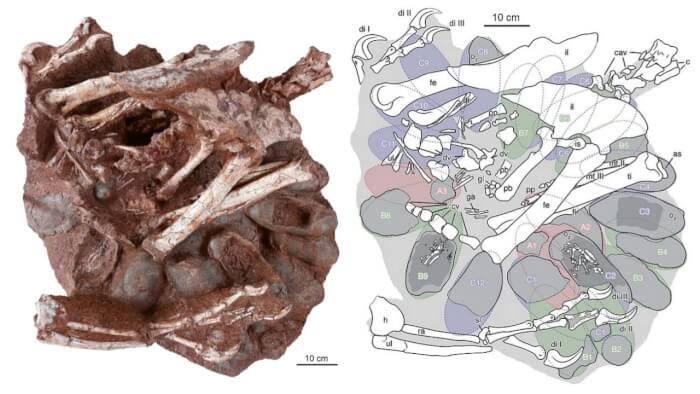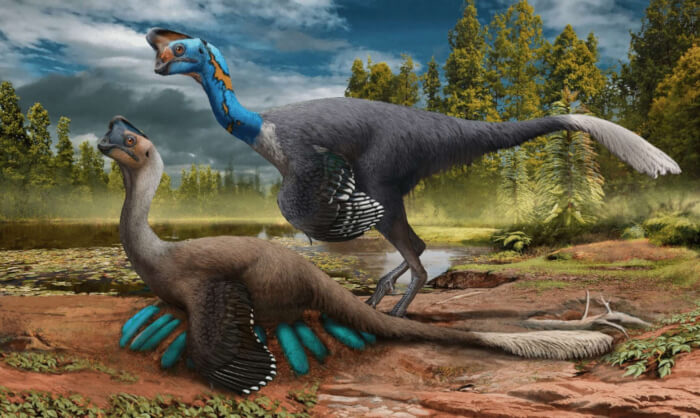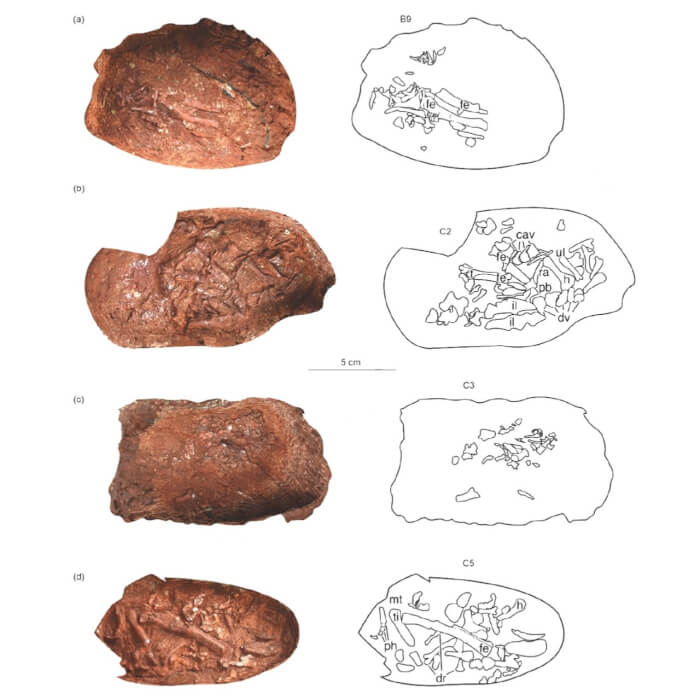Exceptionally Preserved Dinosaur Embryo Discovered Inside Fossilized Egg
Recently, a breakthrough finding has been made in China, specifically in Ganzhou City, southern Jiangxi Province, where archaeologists unearthed skeletal remains of a dinosaur sitting on its nest of fossilized eggs.
This is also the first time a non-avian dinosaur resting on a fossilized egg nest, still containing the baby, has been found.
The adult oviraptor fossils and embryonic eggs have been dated to around 70 million years ago. This is the first time researchers have discovered a non-avian dinosaur resting on a petrified nest of eggs, which still contain the baby within!
The fossil in question is a 70-million-year-old adult oviraptorid theropod dinosaur sitting atop a nest of its petrified eggs. Several eggs (at least three of which contain embryos) are visible, as are the adult’s forearms, pelvis, hind limbs, and a portion of the tail.
Although scientists have spotted adult oviraptors on their nests with eggs before, this is the first time embryos have been discovered within the eggs. Dr. Lamanna, a paleontologist from the Carnegie Museum of Natural History, USA, explains: “This kind of discovery, in essence, fossilized behavior, is the rarest of the rare in dinosaurs. Though a few adult oviraptorids have been found on nests of their eggs before, no embryos have ever been found inside those eggs.”
Dr. Xu, a researcher at the Institute of Vertebrate Paleontology and Paleoanthropology in Beijing, China, believes that this uncommon discovery contains a wealth of information, “It’s extraordinary to think how much biological information is captured in just this single fossil.” Dr. Xu says, “We’re going to be learning from this specimen for many years to come.”
In a brooding or protective stance, the dinosaur was discovered crouching over a nest of at least 24 fossilized eggs. This indicates that the dinosaur perished while brooding or protecting its babies.
At least seven of the fossilized eggs still had unhatched oviraptorid embryos inside them. Scientists believe that some of the eggs were on the edge of hatching based on the development of the sources. According to Dr. Lamanna, “This dinosaur was a caring parent that ultimately gave its life while nurturing its young.”
 Source: CNN
Source: CNN
The adult oviraptorosaur was partially preserved brooding over the clutch of at least 24 eggs, at least seven of which contain skeletal remains of the unhatched young. Pictured: a photograph of the fossilised specimens, left, and in illustration, right.
Commonly recognized as an oviraptor, the dinosaur belongs to a group of bird-like theropod dinosaurs flourishing throughout the Cretaceous Era, 145 to 66 million years ago. Scientists date back the adult oviraptor fossils and embryonic eggs to around 70 million years ago.This is also the first time a non-avian dinosaur resting on a fossilized egg nest, still containing the baby, has been found.
The adult oviraptor fossils and embryonic eggs have been dated to around 70 million years ago. This is the first time researchers have discovered a non-avian dinosaur resting on a petrified nest of eggs, which still contain the baby within!
The fossil in question is a 70-million-year-old adult oviraptorid theropod dinosaur sitting atop a nest of its petrified eggs. Several eggs (at least three of which contain embryos) are visible, as are the adult’s forearms, pelvis, hind limbs, and a portion of the tail.
What do scientists have to say about the discovery?
 Source: CNN
Source: CNN
An oviraptorid specimen consisting of an adult skeleton preserved atop an embryo-bearing egg clutch.
Dr. Shundong Bi of the Centre for Vertebrate Evolutionary Biology, Institute of Palaeontology, Yunnan University, China, and Department of Biology, Indiana University of Pennsylvania, USA, stated in a press release, “Dinosaurs preserved on their nests are rare, and so are fossil embryos. This is the first time a non-avian dinosaur has been found, sitting on a nest of eggs that preserve embryos, in a single spectacular specimen.”Although scientists have spotted adult oviraptors on their nests with eggs before, this is the first time embryos have been discovered within the eggs. Dr. Lamanna, a paleontologist from the Carnegie Museum of Natural History, USA, explains: “This kind of discovery, in essence, fossilized behavior, is the rarest of the rare in dinosaurs. Though a few adult oviraptorids have been found on nests of their eggs before, no embryos have ever been found inside those eggs.”
Dr. Xu, a researcher at the Institute of Vertebrate Paleontology and Paleoanthropology in Beijing, China, believes that this uncommon discovery contains a wealth of information, “It’s extraordinary to think how much biological information is captured in just this single fossil.” Dr. Xu says, “We’re going to be learning from this specimen for many years to come.”
The fossilized eggs were about to hatch!
 Source: PNSO
Source: PNSO
An attentive oviraptorid theropod dinosaur broods its nest of blue-green eggs while its mate looks on in what is now Jiangxi Province of southern China some 70 million years ago.
The scientists discovered an adult oviraptor’s fragmentary skeleton with stones in its stomach. This is an example of gastroliths, “stomach stones,” which the creature had consumed to help it digest its food. It’s also the first instance of undisputed gastroliths discovered in an oviraptorid, which the scientists feel might help shed light on the dinosaurs’ nutrition.In a brooding or protective stance, the dinosaur was discovered crouching over a nest of at least 24 fossilized eggs. This indicates that the dinosaur perished while brooding or protecting its babies.
 Source: CNN
Source: CNN
Analysis of the fossil embryos (pictured) revealed that, while all were well-developed, some had reached a more mature stage than others suggesting that, had they not been buried and fossilised, they would likely have hatched at slightly different times.
However, when the researchers utilized oxygen isotope analysis on the eggs, they discovered that they had been incubated at high, bird-like temperatures, lending credence to the theory that the adult perished while brooding its nest.At least seven of the fossilized eggs still had unhatched oviraptorid embryos inside them. Scientists believe that some of the eggs were on the edge of hatching based on the development of the sources. According to Dr. Lamanna, “This dinosaur was a caring parent that ultimately gave its life while nurturing its young.”
Share this article
Advertisement